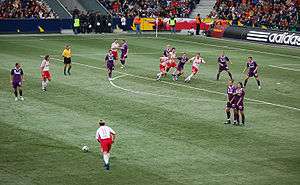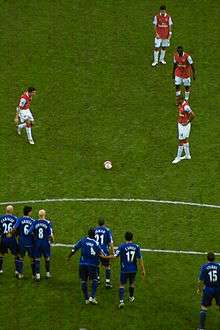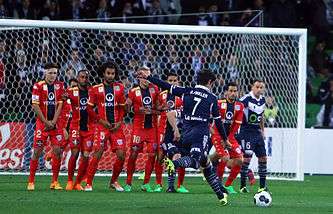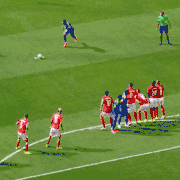Direct free kick

A direct free kick is a method of restarting play in a game of association football that is awarded to a team following most types of fouls. In a direct free kick, the fouled team is entitled to freely kick the ball from the spot of the foul, with opponents required to be at least 10 yards (9.1 m) from the ball. The kicking team may score a goal directly from a direct free kick, that is, without the ball having first touched another player. This is in contrast with an indirect free kick – a restart with a similar procedure that is usually awarded for technical infringements – where the ball must contact another player before a goal is scored. If a player commits a foul punishable by a direct freekick within his/her own penalty area, a penalty kick is awarded instead.
Direct free kicks awarded near the opponent's goal can often lead to scoring opportunities, either from the kick itself or from an ensuing set piece. Accordingly, developing plays from free kicks are an important part of team strategy, and defending against them is an important skill for defenders.
Procedure

The kick is taken from where the foul occurred, unless it was within the fouled team's own goal area, in which case it may be taken from anywhere within the goal area. The ball must be stationary prior to being kicked. Opponents must remain 10 yards (9.1 metres) from the ball (and outside the penalty area if the kick is taken from within the kicking team's penalty area) until the ball is in play.
The ball becomes in play as soon as it is kicked and moves, unless the kick was taken from within the kicking team's penalty area, in which case it is in play once it has passed directly beyond the penalty area.
A goal may be scored directly from a direct free kick, but only against the opposing side (i.e. an own goal may not be scored). Should the ball directly land in the kicking team's own goal, a corner kick is awarded to the opposing team.[1] A player may be penalised for an offside offence committed from a direct free kick; with the exception of receiving the ball directly from a goal kick or corner kick.
Quick free kick
A team may choose to take a "quick" free kick, that is, take the kick while opponents are within the 10-yard (9.1 m) minimum required distance. This is usually done for some strategic reason, such as surprising the defence or taking advantage of their poor positioning. The referee has full discretion on whether to allow a quick free kick, and all other rules on free kicks still apply. However, in taking a quick free kick the kicking team waives their entitlement to retake the kick if an opponent who was within 10 yards intercepts the ball.[1] Football governing bodies may provide further instruction to referees on administering quick free kicks; for example, the United States Soccer Federation advises that referees should not allow a quick free kick if a card is shown prior to the restart, if a trainer has to enter the field to attend to an injured player, if the kicking team requests enforcement of the 10-yard rule, or if the referee needs to slow the pace of the match (e.g., to talk to a player).[2]
Scoring opportunities

There are various techniques used with direct free kicks. First, the player taking the direct free kick may blast the ball as hard as he can, usually with the laces of the boot. Alternatively, some players try to curl the ball around the keeper or the wall, with the inside or outside the boot. Additionally, certain free-kick specialists will choose to kick the ball with minimal spin, making the ball behave unpredictably in the air (similar to the action of a knuckleball pitch in baseball). The kicker may also attempt to drive the shot under the wall formed by the opposition defenders. Free kick takers may also attempt to cross the ball to their centre-backs or strikers to get a header on goal, since they usually are the tallest members of the team, especially if the position of the free kick is close to the wings.
Infringements and sanctions
.jpg)
If an opponent is less than 10 yards (9.1 m) from the spot where the kick is taken, the kick is re-taken unless the kicking team chooses to do a quick free kick (see above). An opponent also may be cautioned (yellow card) for failing to retreat 10 yards.[1]
For a kick taken by a team inside their own penalty area, the ball is not considered in play until it has left the area. If the ball fails to travel directly out of the penalty area the kick is retaken.
The kicker will concede an indirect free kick to their opponents if they touch the ball again before another player (of either team) has touched it. If this second touch is an illegal handling of the ball offence, this takes priority and is penalised (with a direct free kick or penalty) accordingly.
Strategy

Most teams have one or two designated free kick takers, depending on the distance from goal and the side of the field the free kick is to be taken from. The strategy may be to score a goal directly from the free kick, or to use the free kick as the beginning of a set piece leading towards a goal scoring opportunity.
The kicking team may have more than one player line up behind the ball, run up to the ball, and/or feint a kick in order to confuse or deceive the defence as to their intentions; this is usually legal as long as no other infringements occur.
Where there is a potential for a shot on goal to occur from a direct free kick, often the defending side will erect a "wall" of players standing side-by-side as a barrier to the shot. The number of players composing the wall varies based on distance and strategy. It is not fully known when the wall was started. A kicker who has the skill to curl the ball around a wall is at a distinct advantage. Since 2000, referees at the highest levels of football have used vanishing spray to enforce the 10-yard minimum required distance for the wall; referees without vanishing spray may indicate the minimum distance verbally and/or with hand gestures.
See also
References
- 1 2 3 LAW 13 – FREE KICKS – The direct free kick -FIFA.com
- ↑ "Free Kick and Restart Management" (PDF). United States Soccer Federation. 10 February 2009. Retrieved 10 July 2018.
External links
| Wikimedia Commons has media related to Free kick. |